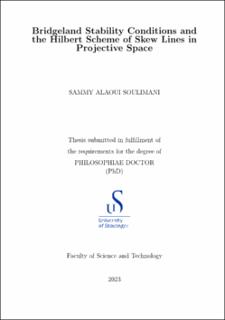| dc.contributor.advisor | Guldrandsen, Martin G. | |
| dc.contributor.author | Soulimani, Sammy Alaoui | |
| dc.date.accessioned | 2023-03-15T14:33:50Z | |
| dc.date.available | 2023-03-15T14:33:50Z | |
| dc.date.issued | 2023-03 | |
| dc.identifier.citation | Bridgeland Stability Conditions and the Hilbert Scheme of Skew Lines in Projective Space by Sammy Alaoui Soulimani, Stavanger : University of Stavanger, 2022 (PhD thesis UiS, no. 687) | en_US |
| dc.identifier.isbn | 978-82-8439-151-9 | |
| dc.identifier.issn | 1890-1387 | |
| dc.identifier.uri | https://hdl.handle.net/11250/3058550 | |
| dc.description.abstract | Bridgeland stability conditions are powerful tools for studying derived categories, with several applications to algebraic geometry. They were introduced by Bridgeland in 2002 [Bri07], who was motivated by Douglas’ work on Π-stability of D-branes [Dou02] in the context of string theory. Bridgeland showed that the set Stab(D) of stability conditions on a triangulated category D is a complex manifold, a result of extreme importance and central to all mathematical applications of this field of study. But in order to use this concept of stability conditions in string theory (as intended by Bridgeland), one needs to prove the existence of stability conditions on the bounded derived category Db(X) of a compact Calabi-Yau threefold X. This task is far from easy, as it took more than a decade before the first example was produced for the smooth quintic threefold by Li in [Li18]. This achievement came into fruition thanks to the extensive amount of work in the domain over this period of time, where the existence of stability conditions was progressively established for arbitrary smooth projective varieties of dimension one [Bri07, Oka06, Mac07], dimension two [Bri08, AB13], and then some dimension three cases (see Section 1.3).
One of the main applications of stability conditions on Db(X) (for an arbitrary variety X) is to study the geometry of moduli spaces of coherent sheaves over X with some Chern character v via the strategy known as “wall crossing”. In loose terms, a “wall” is a codimension one submanifold of Stab(Db(X)) such that by changing stability conditions along a continuous path in Stab(Db(X)) that goes through the wall causes the moduli space of sheaves over X with Chern character v to transform. When X is of dimension two, we have a solid control over wall crossing thanks to Bayer–Macr`ı [BM11], who provided a full understanding of how moduli spaces of sheaves change as we cross walls, as well as knowing the exact geometrical relationship these walls have with the underlying surface. In addition the precise structure of the walls is known and there are effective techniques to detect them. This thorough picture of wall crossing in dimension two is demonstrated through various complete studies of moduli spaces of sheaves over surfaces [AB13, ABCH13, Mea12].
[...] | en_US |
| dc.language.iso | eng | en_US |
| dc.publisher | University of Stavanger, Norway | en_US |
| dc.relation.ispartofseries | PhD thesis UiS; | |
| dc.relation.ispartofseries | ;687 | |
| dc.rights | Navngivelse 4.0 Internasjonal | * |
| dc.rights.uri | http://creativecommons.org/licenses/by/4.0/deed.no | * |
| dc.subject | matematikk | en_US |
| dc.subject | algebraisk geometri | en_US |
| dc.title | Bridgeland Stability Conditions and the Hilbert Scheme of Skew Lines in Projective Space | en_US |
| dc.type | Doctoral thesis | en_US |
| dc.rights.holder | © SAMMY ALAOUI SOULIMANI 2022 | en_US |
| dc.subject.nsi | VDP::Matematikk og Naturvitenskap: 400::Matematikk: 410 | en_US |

